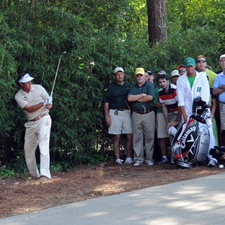I was recently a guest on the “Tee to Green” radio show and was put on the spot when I was asked, “What is my favorite Rule of Golf?” I didn’t have a lot of time to think, but my immediate reaction was to name the Rule that I feel is the most underused Rule in golf, Rule 28 — Ball Unplayable.
Phil Mickelson offered a “case-and-point” demonstration during the final round of the Masters when his tee shot on the par-3 4th hole hit the grandstand and caromed backwards into the woods. When he found his ball he immediately consulted with his caddie (Bones) on what he should do. Many Phil fans, like myself, were yelling at the TV, “Take an unplayable, go back to the tee!” We know he briefly considered it as the TV mic picked up the conversation and we heard him mention it to Bones, but it seemed like he only thought about options B and C under the unplayable ball Rule (see below). Both of these options would only put him deeper into the woods. It didn’t sound like he ever really contemplated going back to the tee under stroke and distance (the first of three options under this Rule) which may have been his best option.
All three options carry a one-stroke penalty. Here are what Phil’s options were:
A) Stroke and Distance. The player can go back to the tee under stroke and distance as this option is always available no matter where the ball is located.
B) He could take the spot where the ball lay, keeping the position of this point between him and the hole and drop a ball on a direct line behind it.
C) He could drop a ball within two club lengths of the point where the ball lay as long as he doesn’t drop closer to the hole.
The trick I use to remember these options under Rule 28 is that we have three of them –‘A’, ‘B’, and ‘C’. ‘A’ stands for “Again” – we can always play the ball “Again” under stroke and distance. ‘B’ stands for “Behind” – we can drop a ball “Behind” the point where the ball lay, keeping it between you and the hole. And ‘C’ stands for “Club” – we can drop a ball within two “Club” lengths from the point at which the ball lay no closer to the hole.
So you can see that Phil was correct in stating that options B and C would only put him further into the woods. And rather than choosing option A, he attempted to play a shot opposite-handed from the woods. Aside from the obvious, this shot came with additional risk factors including that fact that if the ball had deflected and hit him, he would have incurred a one-stroke penalty under Rule 19-2. As it turned out he made triple-bogey 6. If he had declared his ball unplayable and returned to the tee he would have been hitting 3. Maybe he would have hit the green and two-putt for a 5, or even one-putt for a 4. We will never know what the outcome would have been had he declared the ball unplayable, but we know how it turned out when he didn’t. Making 4 on hole #4 would have put him in the playoff at the end. I’m sure if he is ever in a similar situation again he will give it some more thought.


